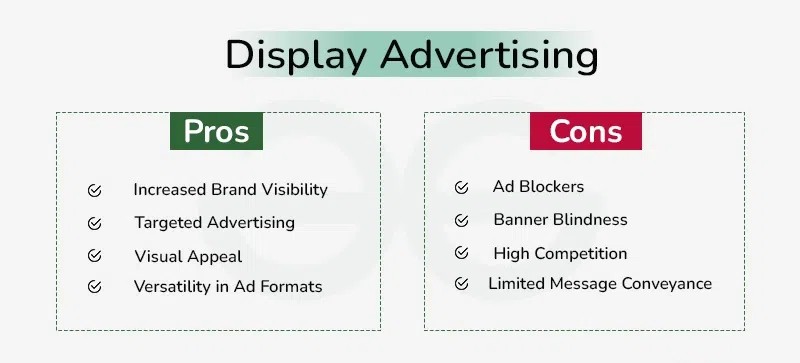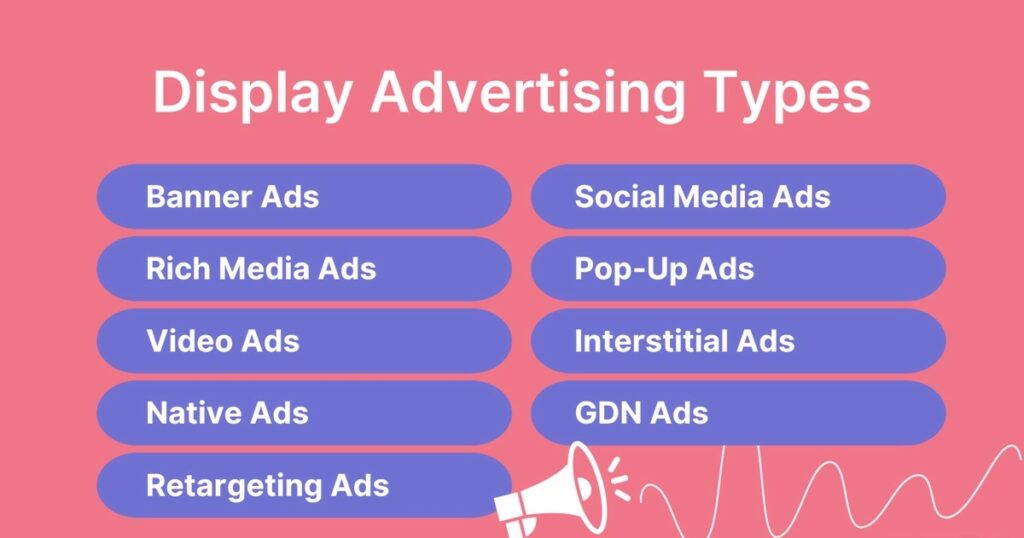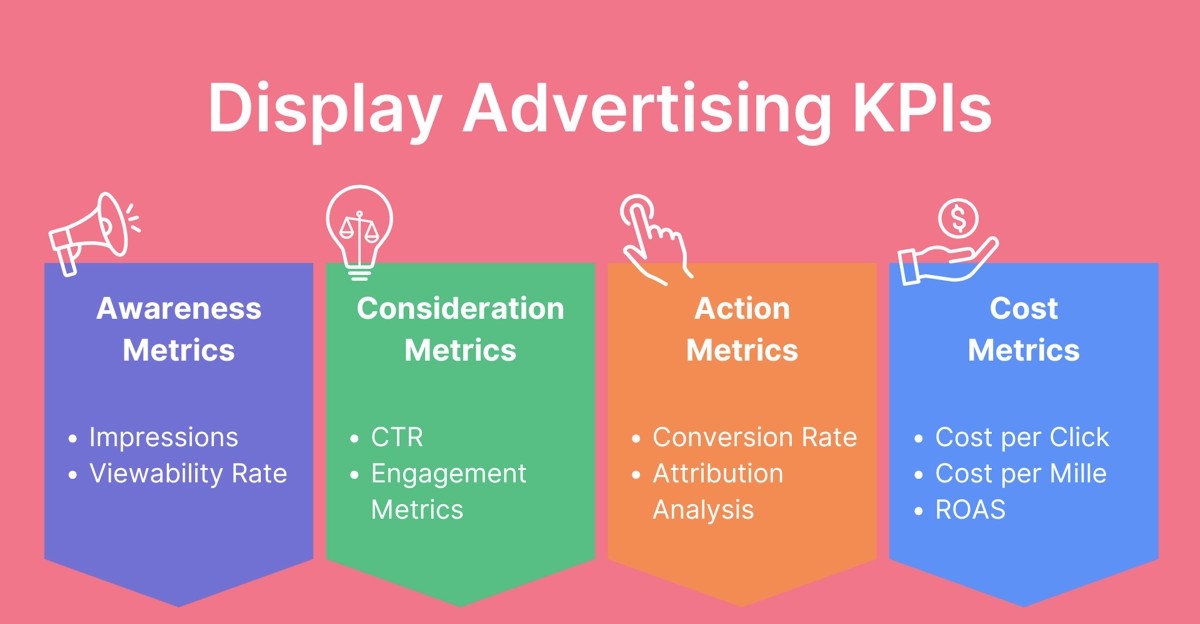Unlocking the Power of Display Advertising:
Types & Tips for Success
Table of Contents

The digital advertising landscape is in a constant state of flux, and by 2027, global spending is estimated to reach $870.85 billion. This growth shows an important transition toward display advertising, which includes not only standard banner ads but also video format ads and a wide array of interesting display campaigns.
When people consider display ads, they think of banner graphics, but contemporary display formats are anything but static; they are animated and multimedia-rich to attract and engage audiences. So, what are display ads? How do they work? What are some best practices to follow to optimize your creativity in a very crowded digital world? Let’s break down the fundamentals of display advertising and how to best leverage it as a marketing medium in this blog. Stay tuned for detailed information.

What is Display Advertising?
Display advertising, sometimes called online or digital display advertising, is a way of promoting a brand’s products or services using some type of visual ad on the internet. The goals of display ads are to:
- Grab Attention: Display ads are designed to grab a viewer’s attention while they are reading websites, scrolling through social media, checking emails, or using apps.
- Generate Clicks: The goal is for the viewer to then click on the display ad and then be directed to their landing page where they can purchase or perform some other desired action.
You can probably recognize display ads because they usually use a combination of text, images, or videos to share a message. Display ads are usually positioned at the top, left side, or right side (or center) of a web page and are usually labeled “sponsored.” They may pop up based on browsing behavior or prior action with the particular brand.

*geeksforgeeks.org
Four Types of Display Ad Formats
You have a variety of display advertising, each serving a different purpose:
- Static Ads: Static ads are non-animated formats that consist of images and text. The best format for creating brand awareness and developing a key visual for your campaign.
- Animated Ads: This is one of the most popular types of display ads that have multiple frames that move to attract attention and are perfect for visually expressing more complex marketing messages.
- Interactive Ads: Interactive ads require user engagement, inviting an audience to engage as they interact with the ad to reveal additional content, enriching the experience.
- Video Ads: Video ads have audio and video components. This type of display ad in digital marketing is effective for remarketing and helping to cultivate interest among prospects who have previously engaged with the company.

*landingi.com
The Role of Display Ads in Digital Marketing
Display ads use images, videos, and pop-ups to engage online users. The main purpose of display ads is to capture attention and build interest in your brand or offer. The features of display advertising include the following:
- Numerous styles: display ads have various formats and sizes, which allows you to choose which ads best align with marketing objectives.
- Visual appeal: display ads quickly create attractive designs to convey more complicated messaging that encourages users to continue engaging.
- Wide distribution: a campaign using the Google Display Network can be shown right in front of users on 35 million websites and apps such as YouTube and Gmail.
- Targeting Capabilities: Advertisers can target ads to specific groups based on geography, interests, and online behavior, getting their ad in front of the right people.
- Measurable Success: Display ads provide measurable metrics that help determine performance. Because of measurable success, marketers can adjust their strategies accordingly while maximizing reach and conversions.
While display ads provide these benefits, they can occasionally be obtrusive to users. Many consumers generally find display ads annoying when they interfere with browsing. However, advertisers have the opportunity to improve user experience by developing interesting and high-quality display ads that provide genuine value.
Personalization and relevance are strategies that an advertiser can use to increase the effectiveness of ads while also trying to reduce the general disdain some users have regarding ads.
How to Create Effective Display Ads
Ready to launch your display ad campaign? Here are some best practices to ensure your ads stand out:
1. Set Specific, Measurable Goals
When implementing any marketing strategy, you will want to start with SMART (Specific, Measurable, Achievable, Relevant, Time-bound) goals. Instead of having a vague goal of “increase conversions,” you want to have a specific and concrete goal, such as “increase leads for Product X by 10% in two months.” This way, you can track your progress and easily measure success.
2. Analyze Demographic Data
It is important to know your audience. Make sure you can reach your target audience through the display networks you are thinking about. Depending on your product’s niche, you may not find a perfect match everywhere. Instead, prioritize networks that assure accurate data and avoid networks that use sketchy tracking or attribution systems.
3. Employ Multiple Marketing Strategies
While display advertising can be effective, it’s even more powerful when combined with other marketing channels. Maintain your SEO, PPC, and social media strategies alongside display ads. This multi-channel approach expands your online presence and connects you with customers who might otherwise slip through the cracks.
4. Optimize Landing Pages
The design of your landing page is just as important as your display ad. After users click your ad, they should land on a page that is fast, functional, and user-friendly. Here are a few best practices for landing pages:
- Build a responsive, mobile-friendly design.
- Keep the layout simple and clean.
- Incorporate your branding elements.
- Add trust signals like testimonials and certifications.
- Ensure your call-to-action (CTA) stands out.
A well-designed landing page can greatly enhance your conversion rates.
5. Design Simple and Compelling Ads
When it comes to displaying ads, being simple is paramount. Your visual message must be easy to understand and should communicate what your offer is, but not so much that the reader is inundated with information. It is most ideal for the user to think to themselves, “Okay, I get what they are offering and why it is important to me.” If an ad looks cluttered or difficult to comprehend, the reader might navigate away from the potential ad or website.
6. Utilize Programmatic Advertising
Programmatic advertising allows you to target specific audiences based on real-time information, including but not limited to demographics and interests, which helps ensure that your ads reach the people who are most likely to take action with your business. You can even create a more customized ad experience for your target audience by using contextual triggers, for example, the weather, which saves you money and creates ad relevance.
7. Craft a Clear Message and Attractive Offer
Your display ad should communicate a clear message and present an attractive offer. At a glance, viewers should understand what the ad is about and what value it provides. For instance, a software company might promote a free trial, while an online store could advertise a seasonal sale. If you’re remarketing, consider incorporating specific product data into your messaging to enhance relevance.

*landingi.com
Become a Digital Marketing Professional
Choosing a career in digital marketing is an exciting and rewarding path! Since this field has become such a key part of business strategies, there’s a huge demand for jobs in this area. If you’re thinking about leaping into digital marketing, register for the Professional Certificate Programme in Digital Marketing for Performance & Growth – IIM Kozhikode.
The programme is to equip professionals with the right skills required to excel in digital marketing and growth hacking. The programme also covers the essential fundamentals of performance marketing and growth tactics and strategies, including search engine optimization (SEO), pay-per-click (PPC) advertising, content marketing, social media marketing, and other tactics.
Programme Key Highlights:
- Certification of Completion from IIM Kozhikode
- Executive Alumni Status – IIM Kozhikode
- Complete digital immersion
- Live project ensures holistic learning
- Faculty from academia and industry with immense experience
- A 360-degree approach in marketing to digital consumers
- Unique proven pedagogies specifically developed for Digital Marketing courses
- Leveraging new immersive tools and technologies in the growing digital landscape
How Can Jaro Education Support Your Marketing Career?
Jaro Education – a leading online higher education and upskilling company providing more than 150+ management, technology, and techno-functional programs in collaboration with top reputed institutes. With its deep expertise in executive education, Jaro Education has successfully transformed the careers of over 300,000 professionals in the past 15 years. This achievement is supported by more than 23 learning centers located in India, Singapore, and the USA. Our team of experts also provides career counselling and academic guidance, ensuring that each candidate receives personalized support tailored to their unique goals.
If you’re registering for the Professional Certificate Programme in Digital Marketing for Performance & Growth through Jaro Education, you can get Jaro Expedite – Career Booster benefits:
- Rigorous development of candidate profiles and resumes.
- Ensures candidates are interview-ready for future workplaces.
- Features sessions led by distinguished industry speakers.
Conclusion
Display advertising is a continually evolving and vital part of today’s digital marketing efforts. In the next 10 years, it will be even more important to have a solid understanding of display formats, relevancy, best practices, and targeting- all of which make up what a great display ad consists of.
When implemented correctly, you can grab attention, increase clicks, and improve conversions, setting your brand up for success in a crowded online space. By keeping a few things in mind, such as setting clear objectives, reviewing your audiences, and optimizing not just your ad but your landing pages, you will have an amazing display advertising experience. The most important part at the end of the day is reaching your audience with visually appealing and relevant content that fits their needs and interests. Tap into the power of display advertising and get ready to see your brand expand and thrive online!
Frequently Asked Questions
1. How important is ad design in display advertising?
Ad design plays a vital role in attracting attention and fostering engagement. Eye-catching visuals, concise messaging, and a compelling call-to-action can greatly enhance the effectiveness of your ads.
2. How can I make the most of my display ad budget?
To maximize your budget, prioritize high-performing ad formats, accurately target your audience, and continually test and refine your campaigns for optimal results.
3. What are the key trends in display advertising for 2025?
Emerging trends include the growing use of AI and machine learning for optimizing ads, a rise in interactive and immersive formats, and an increased emphasis on privacy and data protection.
4. How Can Digital Marketing Benefit My Career?
A career in digital marketing lets you showcase your creativity like few other jobs can. You’ll have plenty of chances to use your skills in writing, graphic design, branding, video production, and more. Plus, there’s a lot of flexibility to think outside the box and come up with innovative ideas in your everyday work
















